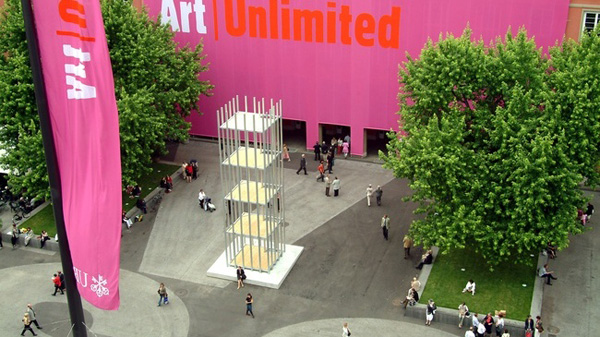The (art) dog days are over, at least for some. The art market, as far art fairs go, seems to be in the greatest of shapes. This week is Art Basel week, the biggest contemporary art fair in the world, which has been reigning in Switzerland, the art collector’s arcadia, since its first edition in 1970. It is still early days, but this year’s edition, with some 300 of the best art galleries from 35 countries, seems to be running nicely, if we are to believe the press with some journalists reporting that they saw collectors literally running to booths on the VIP day last Tuesday as not to lose a purchase to another speeding collector. Our Select Artist Andy Wicks is currently on location there, and we are eagerly waiting his report, to be published in this very blog next week, so watch this space!

Entrance to Art Basel
Despite the collectors and the museums’ permanent collections’ curators, being the essential target of any given first class art fair, the amount of general public that attend them en masse these days makes us wonder: are art fairs the new blockbuster exhibitions, somehow? For –despite the commercial nature of the thing itself, and the overkill of art displayed, bound to overwhelm even the most willing of visitors– more and more art lovers, both high-brow and amateur, seem to think that this is where is at.

A booth at a past edition of Art Basel Miami Beach, with works by Barbara Kruger
So art fairs are clearly on the rise, not unlike the Biennales that mushroomed all over the world during the past decade but with buckets of dealing and commercial transactions added. Art Basel, which also manages the successful Latin America oriented Art Basel Miami Beach, has recently announced the acquisition of Art Hong Kong (or ARTHK), the main player in the Asian art market (and it is all shifting towards Asian markets, as we all know). The second main brand, Frieze –that in only eight editions has become the most exciting and edgy art fair– announced last May that it will launch not one but two new art fairs in 2012: Frieze New York and Frieze Masters in London. Coinciding with Frieze London, Masters will present work made before the year 2000, ranging from antiquities and old masters through to art of the 20th century. Frieze New York will try to replicate the staggering success of the London franchise in the US city, capitalising on the slow decline of the historical Armory Show and sort of competing with Independent, though not coinciding with any of them in the calendar.

Installation view of Alejandro Cesarco's 'The Streets Were Dark With Something More Than Night, or The Closer I Get to the End the More I Rewrite the Beginning' (2011). The artist has won the Baloise Art Prize awarded at this edition of Art Basel.
Sounds complicated? It probably is, like all market strategies. But it all amounts to the same idea: what until quite recently was just an insider affair (for dealers and collectors) is now another reality to be reckoned with in the expanded field of the art world. Art Fairs (bigger, better, faster, everywhere) are here to stay, so it’s probably a good idea to pay attention to what they are telling us.